How to Make Preserved Lemons – Learn to make simple salt-preserved lemons for use in braises, sauces, tagines and recipes. All you need are lemons, a quart jar and salt!
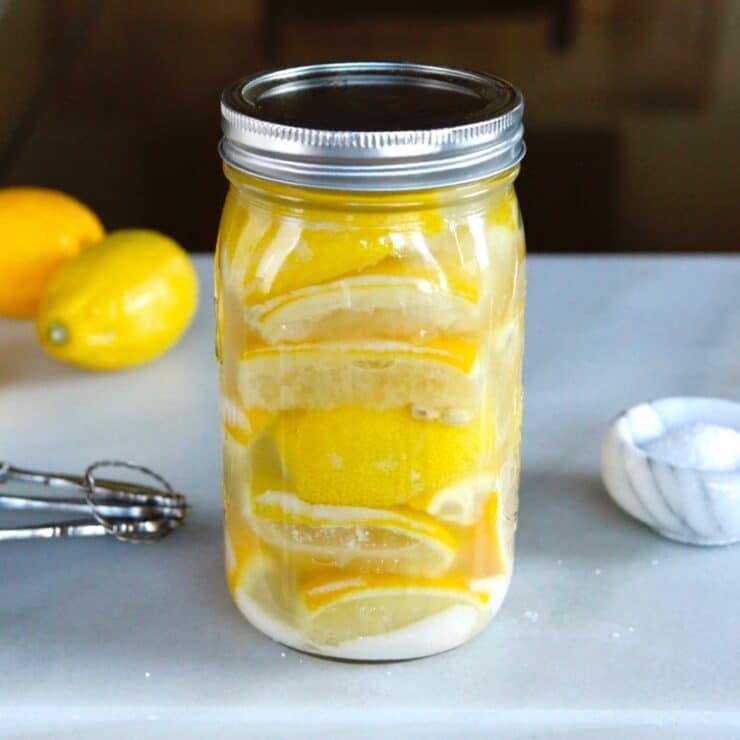
Salt preserved lemons are a technique that stretches back centuries. Ancient techniques of food preservation were greatly important before the days of modern refrigeration, particularly in countries with extended periods of hot weather and limited access to fresh produce. Preserving lemons with salt is one of the simplest and most ancient preservation methods. Salt-preserved lemons originated in the Middle East, though they are now used in cooking all over the world. The process of storing the lemons with salt draws out their juices and causes them to soften over time, removing bitterness from the peel and giving the lemons a wider variety of culinary purposes.
I love cooking with preserved lemons; they have a unique flavor that is distinctly citrusy, while their pucker-inducing tartness is greatly reduced. I add them to braises, fish dishes, sauces and tagines. They brighten the flavor of many dishes. My husband, who adores lemons, eats them straight out of the jar! They pair really well with olives. I also sometimes use the salty, lemony liquid from the jar in salad dressings and sauces (the liquid is quite salty and can veer towards bitter– taste first and add with care!).
Preserved lemons are super easy to make. I always have a jar on hand, just in case I want to add a special flavor to a new dish. You can preserve the lemons sliced whole (the peel still attached in one place) or quarter them; it really doesn’t make a difference how they are sliced. I prefer quartering them because it makes handling them easier, allowing me to stuff the jar with more slices. Generally only the peels are used in cooking, as the lemon flesh soaks up a lot of salt from the preserving liquid, rendering it mushy and very salty.
For a delicious recipe using preserved lemons, try my Moroccan Lemon Chicken with Olives.
Recommended Products:
We are a participant in the Amazon Services LLC Associates Program, an affiliate advertising program designed to provide a means for us to earn fees by linking to Amazon.com and affiliated sites. As an Amazon Associate I earn from qualifying purchases.
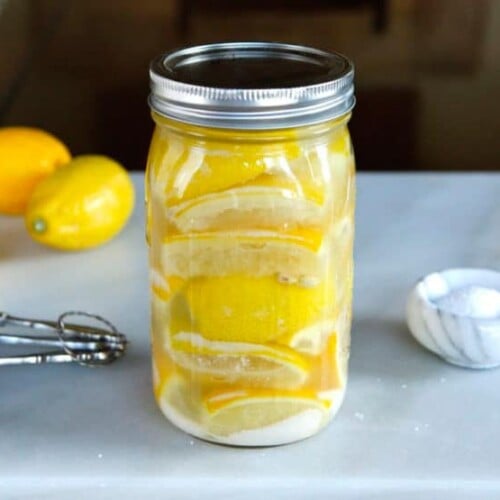
Preserved Lemons
Ingredients
- 6-8 whole lemons
- 4-5 tablespoons salt
NOTES
Instructions
- Start by cleaning your quart jar in hot soapy water. Dry with a clean towel. Clean the outsides of the lemons, rinse and pat dry. Slice the ends from the lemons to create a flat top and bottom.

- Stand the lemon on one of the flat ends. To preserve the lemons whole, cut an "x" in the lemon and stop when you are about 1/2 inch from cutting all the way through.

- The quarters of the lemon remain attached at the base.

- Open the lemon and pour in 1/2 tbsp of salt. Don't worry if some of the salt spills out.

- Once you salt the lemons, pack them into the jar as tightly as possible. You can use a pestle or a wooden spoon to push them in.Once all of the lemons are in the jar, add an additional 1 tbsp of salt. Press on the lemons one more time to extract as much juice as possible.If the lemons are submerged in juice you can secure the lid, if not you may need to add additional fresh lemon juice to top them off.

- Alternatively, after slicing off the ends from the lemons, you can simply quarter them into four separate pieces; the quarters do not need to remain attached at the base. If you use this method, pour 1/2 tbsp salt into the bottom of the jar, place four lemon quarters in the jar, and sprinkle 1/2 tbsp salt evenly on top of the for slices. Repeat with each quartered lemon, alternating layers of 4 slices and 1/2 salt, till the jar is tightly packed with lemon slices. Sprinkle 1 tbsp on top of the final layer of slices.

- Use a pestle to press on the lemons and extract as much juice as possible. Top off the jar with fresh lemon juice if needed.Seal the jar and store the lemons in a cool dry place for at least 1 week. Give them a shake every once in a while to disperse the juice and salt.

- After 1 week, move your lemons to refrigerator. When the peels become translucent, you will know they are soft and ready for use.

- When you are ready to use a lemon, remove it from the jar and rinse to remove excess salt.

- Cut all of the remaining lemon flesh and pith away from the rind and discard.

- Chop the preserved lemon peel according to your recipe, or whichever way you prefer.

- You can store the lemons in the refrigerator for up to 6 months.

Nutrition

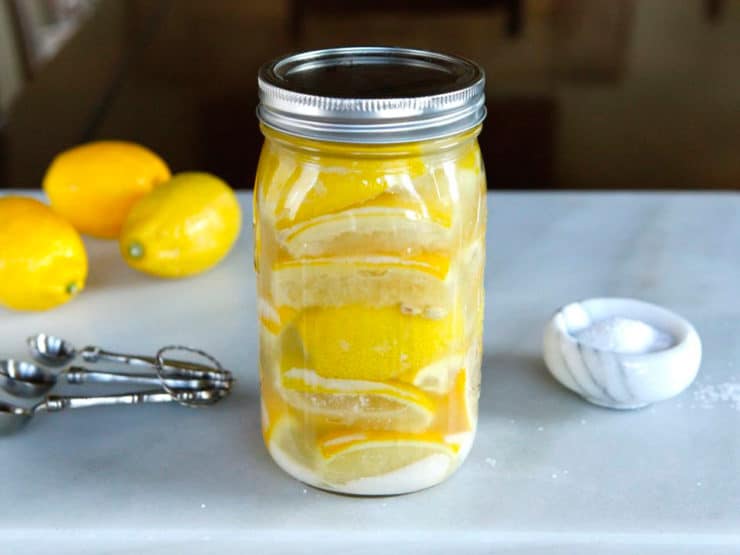
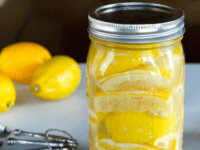
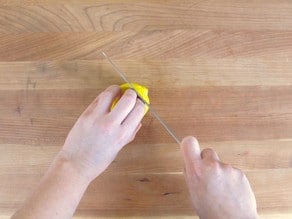
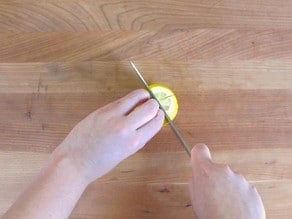
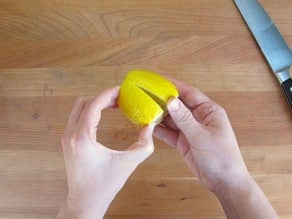
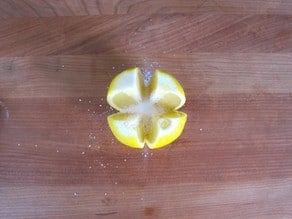
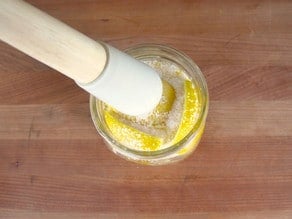
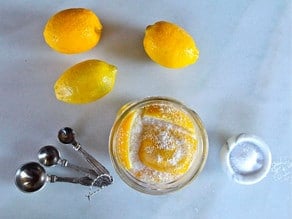
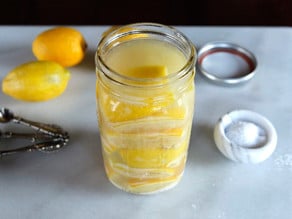
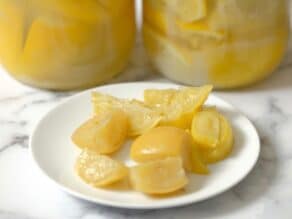
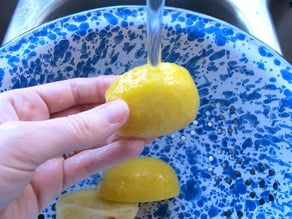
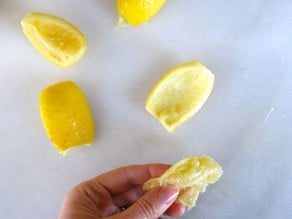
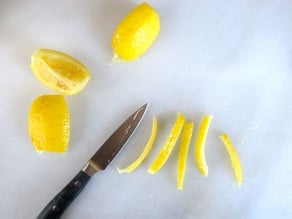
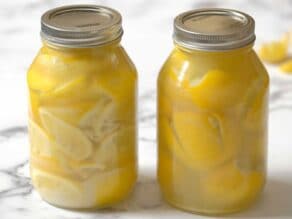


Is this really 1214 % of % Daily Value. If Yes, then that could cause serious health problems. So I must not be understanding this. Right??
The calculation was incorrect (it was calculating a whole jar) – and even the updated one isn’t really correct. Most of the salt used to make the recipe is drained and rinsed away before the preserved lemons are ever used in a recipe. Preserved lemons are typically rinsed, the pulp is removed, and small pieces of the peel are used to flavor other recipes. But I am not sure how to accurately calculate the sodium in the end result, so I am relying on auto-calculation here – just know that a lot of the salt is rinsed away.
Had so much FUN making this. I had no lemons so I used oranges. Can’t wait to try them. I used pints jars and will give one to my Italian friends. Thanks Tori!
Thank you for the recipe! It works really well 🙂
My guest all loved the 🍋 They were so juicy & delicious.
Love this!
Try to avoid iodized salt, this can produce an off-flavor in your pickles. Kosher salt is commonly used for pickling and an excellent choice. Sea salt is “saltier” and each variety has its own subtle differences, experiment with them to create your own signature recipe!
Your website is fantastic, thank you for sharing your beautiful recipes with us.
Thanks Viva!
Ordered the “fruit box” from the Takoma Park Silver Spring Co-Op and got 3 lemons in my box of citrus. Since it’s just me at home, I am trying one out. Looking forward to jazzing up some dishes! Right now am oven drying some oranges. Will get to the grapefruit later.
All the best to everyone!
Thank you for this recipe!!
Now I know what to do with the generous bags of fresh harvested Lemons that I receive from neighbors and friends.
I’m getting geared up to make a batch for gifts at Easter.
There is no mention of what kind of salt is best to use.
With so many kinds of salt available: kosher, iodized, Himalayan, Malden
what do you recommend?
thank you !
I use plain, simple iodized salt (Morton).
Kosher, sea or pickling salt. Iodized salt will mess with the lacto fermentation.
I realize that this is an old question, however just in case someone is arriving late to the party, such as myself, I still thought it important to mention. Try NOT TO USE IODIZED SALT as this can cause your rinds to be bitter which increases the longer they are submerged and stored.
Great tip Teri, thanks for sharing!
I’ve made this during the summer but I couldn’t get the lemons to stay submerged, so it ended up growing mold.
Bought some lemons at Costco yesterday and they are hard as rocks. I quarter and salted them and put them in a jar. Unfortunately no juice has come out so I’m considering buying a bottle of Real Lemon to top it off with and some fermentation weights.
Not sure about Real Lemon… it would probably be better if you can find some juicing lemons and juice them. Real Lemon might have some preservatives that interfere with the fermentation process… not really sure because I don’t use it.
How do you seal the canning jar with the lemons to keep them on the self
Preserved lemons are typically not canned, as they are a fermented food and will last a long time in the refrigerator. Canning will kill the natural fermentation, which is where their flavor comes from.